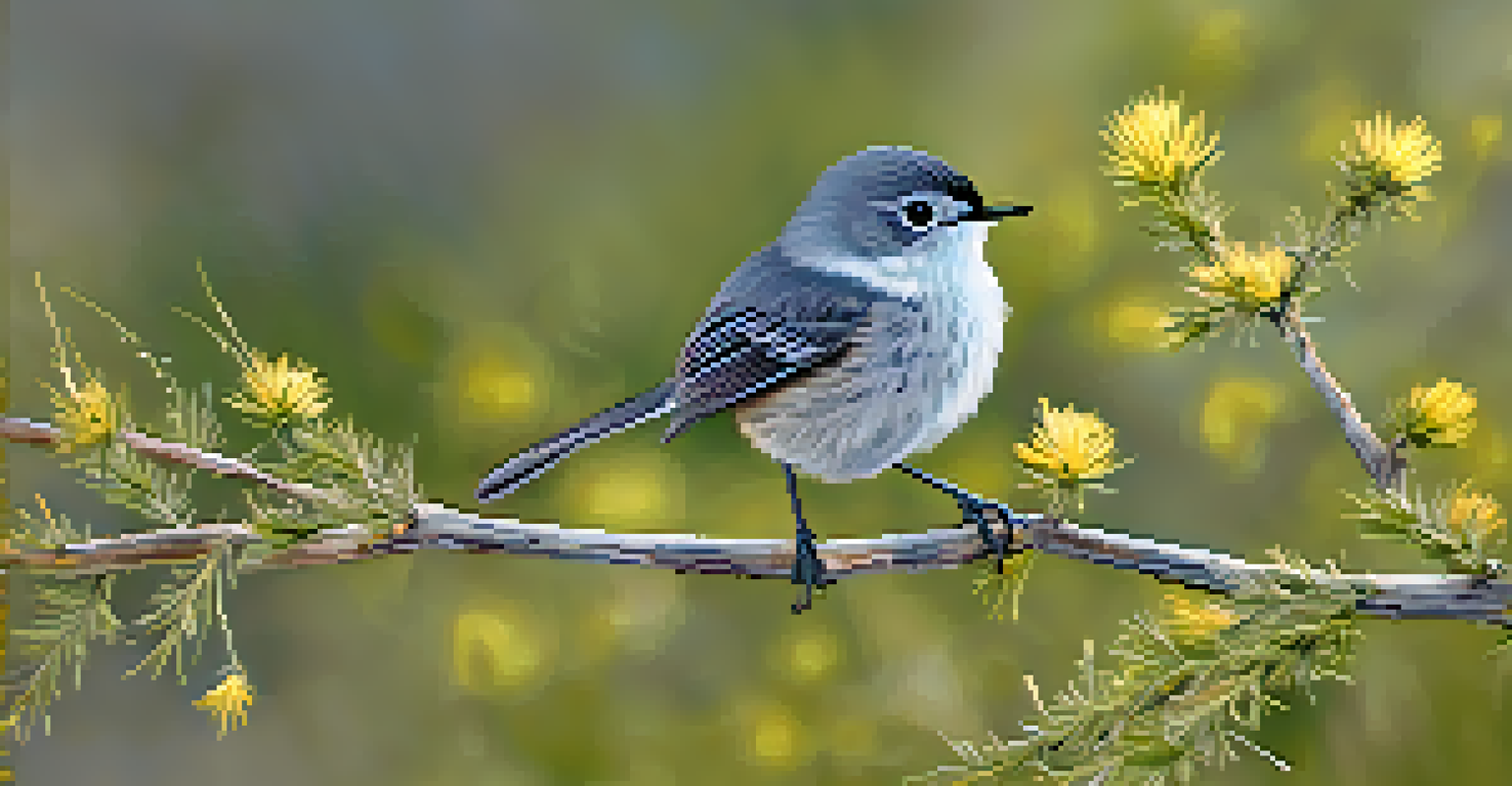How Carlsbad's Climate Affects Local Flora and Fauna

Understanding Carlsbad's Mediterranean Climate
Carlsbad enjoys a Mediterranean climate, characterized by mild, wet winters and warm, dry summers. This climate plays a crucial role in the types of plants and animals that thrive in the area. With average temperatures ranging from the mid-40s in winter to the high 70s in summer, the region provides a comfortable habitat for diverse species.
The environment is where we all meet; where we all have a mutual interest; it is the only thing we all share.
The seasonal rainfall, primarily occurring between November and March, nourishes the local flora during the dry summer months. This cycle creates a unique environment where many native plants have adapted to conserve water, making them well-suited to survive in this climate. Understanding these patterns is essential for appreciating the biodiversity in Carlsbad.
Additionally, the coastal location moderates temperature extremes, allowing both terrestrial and marine ecosystems to flourish. The interplay between land and sea creates a rich tapestry of life, making Carlsbad a fascinating case study for those interested in ecology.
Native Flora: Adaptations to Local Conditions
The native flora of Carlsbad showcases remarkable adaptations to its climate, particularly in water conservation. Plants like the California sagebrush and coastal prickly pear have developed thick, waxy leaves to minimize water loss, which is crucial during the hot, dry summer months. Their ability to thrive in nutrient-poor soils also highlights their resilience.

In addition to drought-resistant features, many local plants bloom during the wet season, taking advantage of the available moisture. This blooming cycle not only supports the plants but also provides vital resources for local wildlife, creating a symbiotic relationship between flora and fauna. For instance, the blooming of wildflowers attracts pollinators, which are essential for plant reproduction.
Mediterranean Climate's Impact
Carlsbad's Mediterranean climate fosters diverse plant and animal life, shaped by seasonal rainfall and temperature variations.
Preserving these native plant species is essential for maintaining the ecological balance in Carlsbad. As urban development increases, efforts to protect and restore native habitats ensure that these unique plants continue to thrive and support the diverse animal life that depends on them.
Animal Life: Adaptations to Carlsbad's Environment
Carlsbad's unique climate also influences the animal species that inhabit the area. Many animals have adapted to the region's seasonal changes, allowing them to thrive despite the varying conditions. For example, the California gnatcatcher, a small bird, has adapted its nesting habits in response to the dry summers and wet winters.
The future will be green, or not at all.
Reptiles, such as the Western fence lizard, are commonly found basking in the sun during warm days, while burrowing underground to escape the heat. This behavior highlights a fascinating aspect of adaptation, where animals utilize their environment to regulate body temperature and conserve energy. Such adaptations are vital for survival in a climate that can be both harsh and nurturing.
Furthermore, the interplay between local flora and fauna is crucial; many animals rely on specific plants for food and shelter. For instance, the caterpillars of various butterfly species feed on native plants, while birds rely on them for nesting materials. This interdependence illustrates the delicate balance of Carlsbad's ecosystem.
Impact of Urban Development on Local Ecosystems
As Carlsbad continues to grow, the impact of urban development on local ecosystems cannot be ignored. Expanding infrastructure often leads to habitat loss, which threatens the delicate balance of plant and animal life in the area. Many native species are at risk due to fragmentation of their habitats and increased competition from invasive species.
Efforts to mitigate these impacts include creating wildlife corridors and preserving green spaces. These initiatives allow for the movement of wildlife and help maintain biodiversity in urban settings. By prioritizing these conservation strategies, Carlsbad can ensure that its unique ecosystems remain intact, even amid development.
Urban Development Threats
Expanding urban infrastructure threatens local ecosystems, leading to habitat loss and increased competition from invasive species.
Community involvement is also essential in conservation efforts. Local organizations often engage residents in habitat restoration projects, fostering a sense of stewardship for the natural environment. By encouraging public participation, Carlsbad can strengthen its commitment to protecting local flora and fauna.
Seasonal Changes: Their Effects on Biodiversity
The seasonal changes in Carlsbad significantly influence the behavior and life cycles of local species. During the rainy season, many plants burst into bloom, creating a vibrant ecosystem that attracts a variety of pollinators and herbivores. This explosion of life is crucial for maintaining the food web and supporting the overall health of the environment.
As summer approaches, the landscape shifts, with many plants entering a dormant phase to conserve water. This seasonal rhythm affects animal behavior as well; for example, some birds migrate to find more abundant food sources, while others adapt by feeding on drought-resistant plants. These changes highlight the interconnectedness of seasons and biodiversity in Carlsbad.
Understanding these seasonal dynamics is vital for conservation efforts, as they inform when and how to protect vulnerable species. Implementing strategies that align with these natural rhythms can enhance the resilience of local ecosystems, ensuring they thrive despite the challenges posed by climate change.
The Role of Climate Change on Carlsbad’s Ecosystems
Climate change poses significant challenges to the delicate ecosystems of Carlsbad. Rising temperatures and shifting precipitation patterns can disrupt the seasonal cycles that many species rely on for survival. For instance, if the wet season becomes less predictable, plants may not have enough water to thrive, which in turn affects the animals that depend on them.
Moreover, increased temperatures can lead to more frequent droughts, putting additional stress on already vulnerable native species. As invasive species become more prevalent in warmer conditions, they can outcompete native plants and disrupt the food chain, leading to a decline in local biodiversity. This scenario paints a concerning picture for the future of Carlsbad's unique ecosystems.
Importance of Conservation Efforts
Community-driven conservation initiatives are crucial for protecting Carlsbad's unique biodiversity and restoring native habitats.
Community awareness and proactive measures are essential in addressing these challenges. By promoting sustainable practices and supporting local conservation initiatives, residents can play a vital role in mitigating the effects of climate change on Carlsbad’s flora and fauna.
Conservation Efforts in Carlsbad
Carlsbad is home to several conservation programs aimed at protecting its unique biodiversity. Local organizations work tirelessly to restore native habitats, rehabilitate endangered species, and educate the community about the importance of preserving the environment. These initiatives are critical for ensuring that future generations can experience the rich array of flora and fauna that Carlsbad has to offer.
One notable effort is the establishment of protected areas, such as the Batiquitos Lagoon and the San Elijo Lagoon. These habitats provide refuge for countless species and serve as vital ecosystems for water filtration and storm protection. By preserving these areas, Carlsbad demonstrates its commitment to environmental stewardship.

Engaging the community in conservation efforts is equally important. Many local groups encourage residents to participate in habitat restoration days and educational workshops, fostering a deep understanding of the natural world. These initiatives not only benefit local ecosystems but also instill a sense of pride and responsibility among residents.